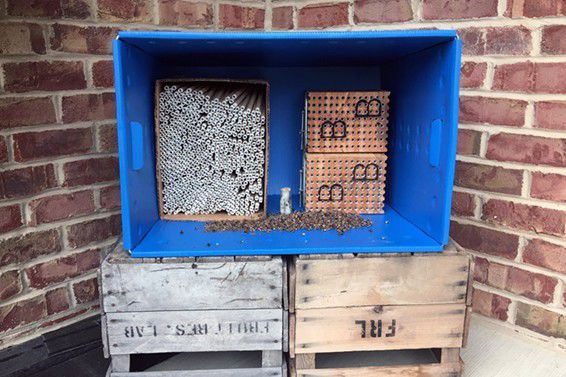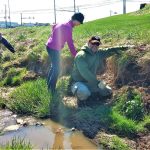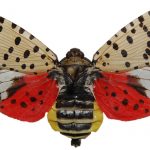While spring is the beginning of the beekeeping season, early blooming plants not only feed honey bees but also hundreds of native solitary bee species that emerge at around the same time.
But who are these bees? Of the at least 438 species of bee species in Pennsylvania, about 33% emerge between March and April and are critical for pollination of a number of native plants and tree fruit crops. Crops that benefit from the pollination services of these bees include apples, pears, cherries, and blueberries.
More than 120 bee species are found in apple orchards in Pennsylvania alone. Besides honey bees, alternative pollinators like mason bees are now managed for orchard pollination. One native (Osmia lignaria) and one introduced mason bee species (Osmia cornifrons) are reared and housed in large numbers of “bee hotels” near orchards to help reach optimal pollination (photo 1). In wild conditions, mason bees use mud to construct their nests inside hollow stems and twigs, but they also use the hollow cavities provided by holes drilled in a wooden block, straws or bamboo shoots in bee hotels. Additional information about the natural history and management of mason bees can be found in the article, Orchard Pollination: Solitary (Mason) Bees. Other common spring species that nest in wood include small and large carpenter bees (photo 2) that may also colonize bee hotels and provide essential pollination services to crops and many other plants in the surrounding native vegetation.
Another important group of spring native bees includes a large number of ground-nesting species that are active for approximately 6 to 8 weeks in the spring. These solitary nesters—meaning there is only one female per nest unlike the hundreds to thousands of individuals found in social insect nests—can often be found in large aggregations, where the nests of hundreds to thousands of females are built near each other on the ground (photo 3). Among the most abundant solitary ground bees, that nest in aggregations in the northeastern US are mining bees (genus Andrena, photo 4) and cellophane bees (genus Colletes, photo 5). The nests of these bees can be easily spotted above ground because of the conical piles of soil with a hole in the middle, which serves as the entrance of the bee nest. Different ground-nesting bee species have different soil texture preferences, but most prefer loose, exposed soil on south-facing slopes, which receive more sun exposure in the spring and therefore are warmer earlier in the season. A few weeks after mining and cellophane bees emerge, it is also common to see cleptoparasitic (a.k.a. cuckoo) bee species. These cuckoo bees do not construct their own nest. Rather, they wait until the females of their host are out foraging, enter their nests, eat the egg of the host, and lay their own egg. Common cuckoo bees include bees in the genus Nomada, which may be confused with wasps (photo 6).
Spring is also the time for the emergence of bumblebee queens, which are often seen buzzing around flowers. Right after the queens emerge from their overwintering sites, they do not have a nest, and they need to eat enough pollen and nectar to regain energy after the winter. In that process, bumblebee queens pollinate a number of early blooming plants. After this feeding stage, queens begin to search for suitable nesting sites, which include holes in the ground (for example old mice nests), protected cavities like garden sheds, and empty bird boxes. Spring is a critical time during the life cycle of bumblebees because every time a bumblebee queen dies at this stage, it means that a colony with hundreds of workers will not develop.
Spring bees are abundant in urban gardens where their nests are commonly found in backyards. Unlike social insects such as honeybees and paper wasps, solitary bees are not aggressive insects (even though females have a stinger). These bees will not attempt to sting humans unless you try to handle them with your hands or you step on them. Because these native bee species provide important ecological services and are not aggressive, they are not considered pests, and it is strongly recommended to avoid the use of chemicals to control them. The overuse or misuse of pesticides can have negative impacts on humans and beneficial insects. Therefore, if controlling ground-nesting bees is absolutely necessary, rather than using a chemical treatment, consider adding water over the area of the aggregation to encourage the bees to look for a different nesting site.
Finding nest aggregations of these native bee pollinators can be difficult. It is extremely important to know where these bees live, when they are active, what they are feeding on, and what level of disease pressure they have. The López-Uribe lab is gathering information about the locations of these nesting sites across Pennsylvania and the northeastern US to better understand how these factors affect the health of native bees. If you have any of these nest aggregations in your backyard or your field, please consider participating in our citizen science project “Bee Germs.”
For more info and photos, click here.




